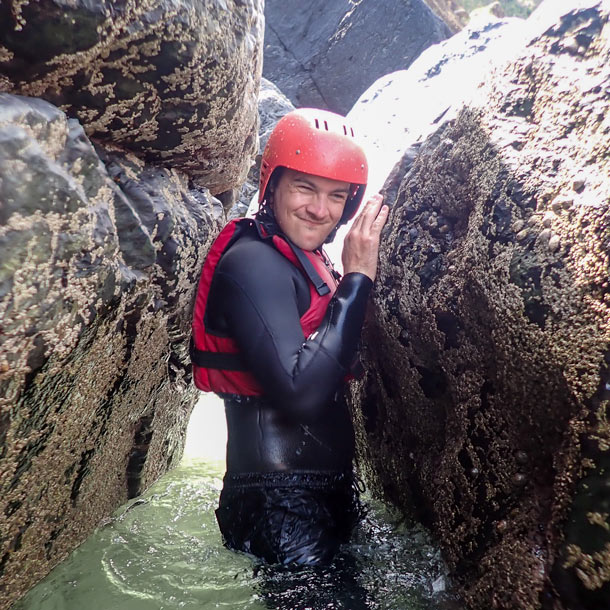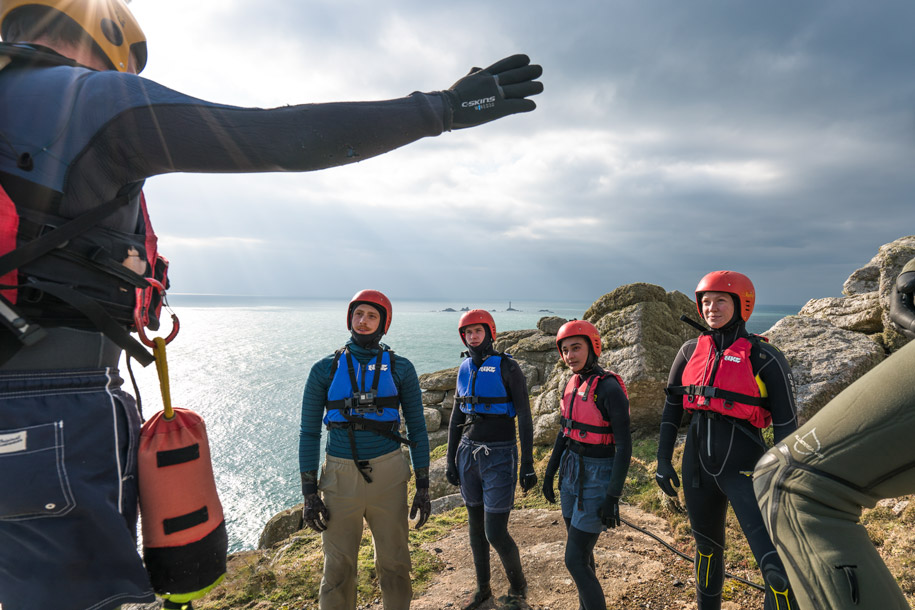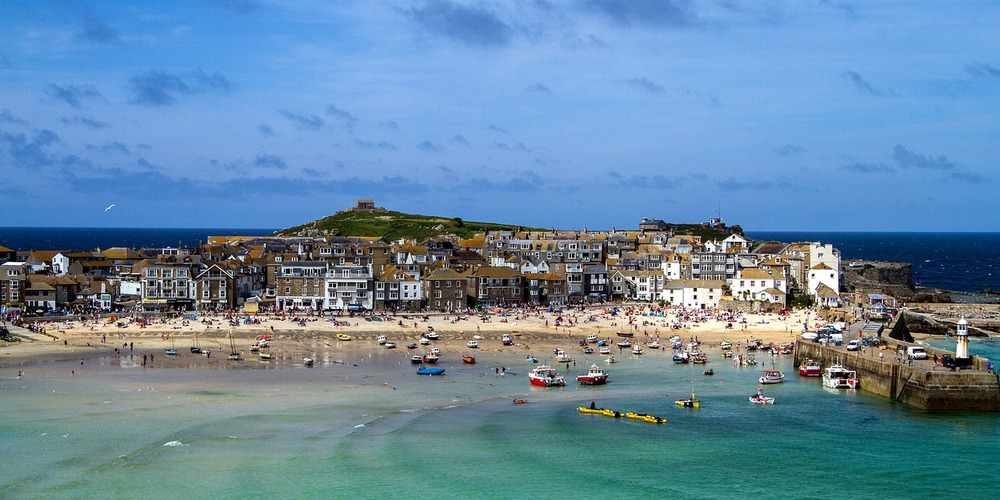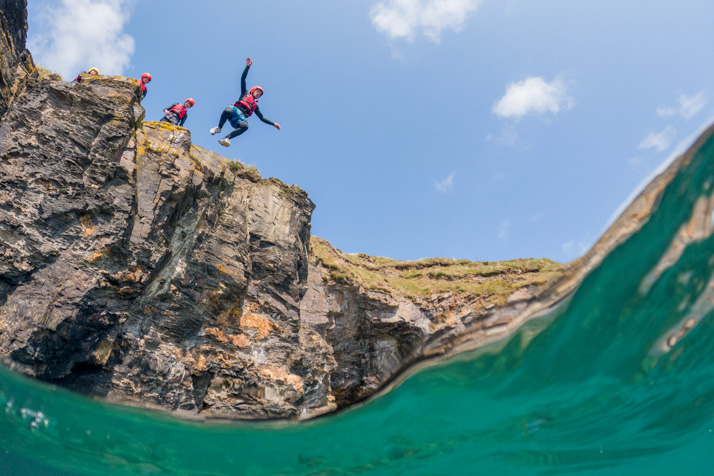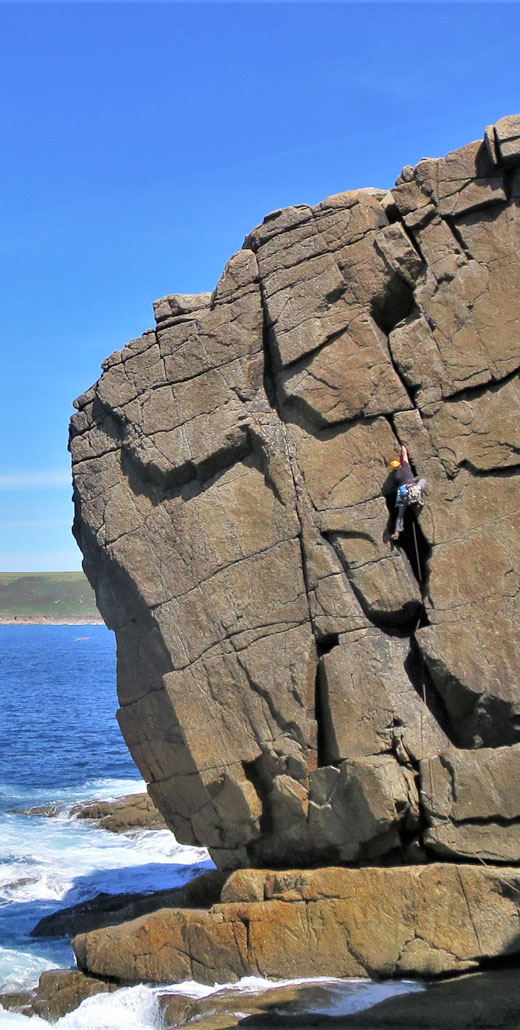Coasteering and rock climbing fAQs
Got questions about booking coasteering or climbing?
We’ve got the answers!
Coasteering FAQ
What is coasteering? Where does it happen? Who can do it? Find the answers to all these questions and more here.
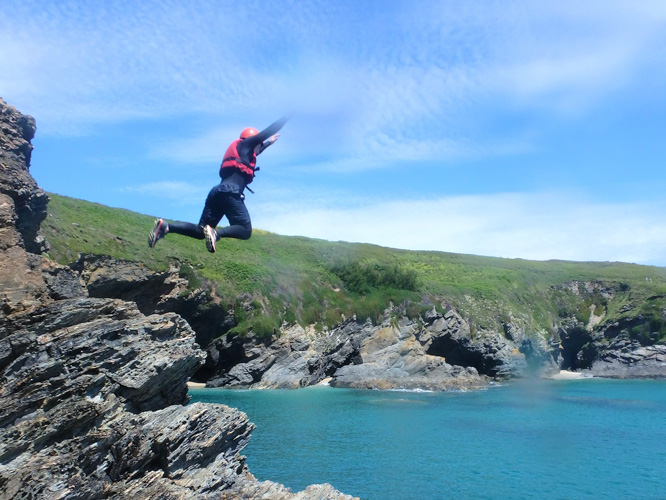
Coasteering is an adventurous way to explore the coastline at sea level — combining scrambling, sea swimming, low-level climbing, and cliff jumping. You’ll travel along the intertidal zone, discovering sea caves, arches, and unique coastal features that are often inaccessible by any other means. It’s one of the most exciting outdoor activities in Cornwall, offering a completely different perspective on the landscape.
Like any adventure sport, coasteering carries some risks — but safety is always our top priority. Every session is led by highly experienced guides who are experts in managing sea and weather conditions, selecting suitable routes, and adapting to the group’s abilities.
We provide full safety equipment, including wetsuits, buoyancy aids, helmets, and all necessary gear. Our leaders also hold nationally recognised outdoor qualifications — such as rock climbing instructor and mountain leader certifications — alongside valid first aid training.
As an AALA licensed provider, we operate under strict safety standards, ensuring your coasteering adventure is as safe and enjoyable as possible.
Yes — with the exception of our Advanced Coasteering at Land’s End route, all of our sessions are designed to welcome beginners. You don’t need any previous experience, just a basic level of fitness, some confidence in the water, and a willingness to give it a go. We adapt every route to suit the day’s conditions and the group’s abilities. For anyone feeling especially nervous, we also offer Beginner Coasteering Sessions — a gentler introduction at carefully chosen locations.
We provide all specialist safety equipment — wetsuits, buoyancy aids, helmets, and any technical kit required. You need to bring:
- Lace-up trainers you don’t mind getting wet (essential for grip and safety on the rocks).
- Swimwear to wear underneath your wetsuit.
- Board shorts or swim shorts to wear over the wetsuit (required — they help protect the wetsuits and improve comfort).
- Towel to dry off afterwards.
You may also want to bring:
- Spare warm clothes to change into after your session.
- Suncream or warm layers depending on the weather.
- A drink for after your session.
A full kit list is provided upon booking.
Want to know more about the equipment we use on our coasteering adventures?
Take a look at our detailed Coasteering Equipment Guide.
For most of our sessions, the minimum age is 9 years old. Our advanced routes (such as Land’s End) have higher age limits and experience requirements. Children under 14 must be accompanied by a parent or guardian. All under-18s must have a consent form signed by a parent or guardian.
If you have younger participants in your group (aged 9 or 10), please let us know when booking. If rough sea conditions are forecast for the day of your activity, we may contact you in advance to discuss options or advise rescheduling.
We offer guided coasteering across some of the best locations in west Cornwall, including:
- Praa Sands — our main venue, ideal for beginners and families.
- Land’s End — for more experienced participants seeking a serious adventure.
- Isles of Scilly (St Mary’s) — we are the exclusive providers of coasteering in the islands
We select the location based on conditions to give you the best experience on the day.
Our main season runs from Easter through to autumn, when sea temperatures and conditions are generally most favourable. However, with the right kit and weather windows, we can offer coasteering year-round.
Winter sessions depend entirely on sea conditions and are typically better suited to experienced participants. We provide high-quality winter wetsuits if conditions allow, but cold weather, swell, and limited daylight all factor in.
If you’re interested in a winter session, feel free to contact us — we’ll advise honestly based on safety and conditions.
All of our coasteering sessions are led by highly experienced guides with years of hands-on knowledge of Cornwall’s coastline. While there’s no formal national governing body for coasteering qualifications, we hold an Adventure Activities Licensing Authority (AALA) licence, which confirms that our safety standards, operating procedures, and staff training meet the highest standards for running adventurous activities.
Our lead guides also hold nationally recognised qualifications in related fields such as rock climbing instruction, mountain leadership, and first aid. Safety, experience, and sound judgement are at the heart of every session we run.
Yes. Kernow Coasteering holds full public liability insurance up to £10 million and operates under a valid AALA licence for adventure activities. Copies of insurance and risk assessments are available on request.
Coasteering:
Spectators are welcome at some coasteering locations, though what you can see depends on the route we’re using on the day:
- Isles of Scilly (Peninnis Head): Excellent viewing — family and friends can often get close to the action and take photos.
- Praa Sands and other west Cornwall routes: Some vantage points are possible depending on the route and conditions.
- Land’s End Advanced Coasteering: Not suitable for spectators — most of this route is hidden from view and not safely accessible.
Rock Climbing:
- Beginner Climbing: Excellent for spectators — family members can easily join us at the base of the cliffs and watch the session up close.
- All other climbing courses: Spectating is not possible — the venues are remote and only safely accessible to participants under instructor supervision.
Spectators are responsible for their own safety at all times.
As a mobile outdoor provider, we don’t have dedicated changing rooms — most people simply change at the beach or parking area using a towel or changing robe.
Even at our Isles of Scilly base, facilities are limited to a secure storage container, not indoor changing rooms. If you have particular privacy needs or concerns, feel free to contact us in advance so we can advise — but please bear in mind that facilities are very basic, and part of the nature of outdoor adventure
Contact lens wearers should have no problem wearing their lenses when coasteering. As it happens, Matt, owner of Kernow Coasteering, wears contact lenses for every coasteering session he does and he’s never lost one. That being said, we cannot rule out the possibility of losing a contact lens whilst coasteering. If you do not have spares with you, or simply cannot afford to lose them, you may want to consider removing them before entering the water.
People do wear glasses when coasteering with us. Ideally, you have a bespoke retaining strap that will keep them in place. If not, we can fashion something out of a shoelace and a couple of cunning knots. Start with small jumps and see how they feel before progressing to larger jumps.
The inter-tidal zone in which we do our coasteering is teeming with wildlife. Almost every rock surface is covered in some kind of life, from barnacles and limpets to various seaweeds and algae. Low tide reveals an unbelievable hidden world of brightly coloured seaweeds and sponges and even starfish which can look positively psychedelic.
In terms of larger animals, the cliffs are home to numerous sea birds, the most common of which are herring gulls, cormorants and shags. It’s great to be able to see them in their natural environment. Of course, if we are lucky we may even have an encounter with a seal or two. On some of our coasteering routes, we see them almost every visit, whilst at others, we see them infrequently.
We’ve only seen dolphins once or twice when we’ve been coasteering, so if you are lucky enough to see them coasteering with us, consider yourself extremely lucky.
Whether it is raining has no bearing on whether we can go coasteering or not, as we will be spending much of our time in the sea anyway. In fact, rainy days are perfect for coasteering – it certainly beats a day stuck indoors!
Make no mistake, the seas around Cornwall are never warm! The sea temperatures range from 9 degrees celsius in the winter, up to about 17 degrees in the summer. You can find more information about Cornish, as well as national sea temperatures here.
With that in mind, we use good quality winter thickness wetsuits all year round. That means when you’re coasteering with us you will be comfortably warm throughout the activity. If you come coasteering with us in the colder months we can provide you some wetsuit gloves as well.
Coasteering is weather dependent, and sometimes rough seas or unsafe conditions mean we have to postpone or cancel a session. We monitor forecasts carefully and will always contact you as early as possible if we need to make changes.
In most cases, we’ll aim to reschedule your booking to a suitable alternative date. If that isn’t possible, we offer a full refund for any session we cancel due to conditions.
Yes, we can offer private coasteering sessions for you and your group. Note, that these are subject to availability and may not be available during the school summer holidays.
Private sessions are a great option, allowing us to tailor the coasteering specifically for your group’s abilities. That may mean a very mellow session at a sheltered spot, great for younger coasteerers. Or it may mean you prefer to ramp it up and have a coasteering session filled with as many jumps and challenges as possible.
A reasonable level of fitness and swimming ability is required for coasteering, but you do not need to be an athlete.
- If you can swim 50m comfortably, that’s generally sufficient.
- For climbing, general mobility and an absence of major joint problems is usually enough.
Specific activities (like Advanced Coasteering at Land’s End) may require greater fitness, but we’re always happy to advise on suitability.

Rock climbing FAQ
All your questions about rock climbing in Cornwall with us, whether it’s your first time, or whether you’re a regular rock jock!
Not at all. We offer courses for complete beginners with no prior climbing experience. Our beginner climbing courses in Cornwall are designed to introduce you to outdoor rock climbing safely and enjoyably, even if you’ve never climbed before.
Yes, children from age 5 and up can participate in climbing activities, provided they’re accompanied by a parent or guardian. We tailor routes to suit different ages and abilities, ensuring children can enjoy climbing safely while learning essential skills.
We use a variety of sea cliff crags across West Cornwall, from Land’s End to Porthleven, offering spectacular coastal climbing in stunning surroundings. All routes are carefully selected to suit the group’s ability and the day’s conditions.
For those staying in mid or north Cornwall, we also run sessions at Roche Rock — an inland granite crag that’s easily accessible from much of the county.
Depending on experience level, your course may take place at world-class sea cliff venues such as Sennen (used for our Intermediate Trad Climbing courses) or iconic crags like Bosigran and Chair Ladder (used for our Lead & Multi-Pitch Climbing courses).
If you’d like to learn more about the types of locations we use, our climbing page gives a detailed overview.
Outdoor climbing carries inherent risks, but our courses are run with the highest safety standards. All sessions are guided by fully qualified and highly experienced instructors holding Mountain Training climbing awards.
We also hold an AALA licence for our activities, ensuring compliance with national safety standards.
Expect plenty of time actually climbing Cornwall’s superb granite sea cliffs, with routes carefully chosen to suit your ability and the day’s conditions.
You’ll learn how to use the equipment, belay safely, and develop solid climbing technique — all while experiencing some of the UK’s best coastal climbing.
Our sessions focus on practical skills, building confidence as you progress on real rock under close supervision.
We provide all technical climbing equipment, including harnesses, helmets, ropes, and hardware. You simply need to bring suitable clothing for the weather, sturdy footwear for the walk-in, a packed lunch, plenty of water, and a rucksack to carry your gear in.
A full kit list is provided when you book.
Want to know more about the gear we use?
Check out our full set of climbing gear guides:
A reasonable level of fitness and mobility is helpful, but no extreme fitness is required. Our beginner courses are accessible to most people with average fitness. If you have specific concerns, feel free to contact us before booking.
Yes — many of Cornwall’s climbing venues are set directly above the sea or close to beaches, offering beautiful settings for both climbing and relaxing afterwards. However, not all crags are suitable for beginners or unguided visits due to safety factors like tides and cliff access.
All climbing courses are delivered by instructors holding nationally recognised Mountain Training awards such as the Rock Climbing Instructor (RCI) or Mountaineering and Climbing Instructor (MCI). Instructors also maintain valid first-aid qualifications and have extensive local knowledge of Cornwall’s climbing venues.
Climbing wet rock is no fun at all. So if the weather forecast is dreadful, we will postpone your activity, or offer you an alternative, such as coasteering.
If maybe one or two showers are forecast, we will probably head out, so if that’s the case make sure you bring some extra layers and some waterproofs in case we need to shelter briefly. If the weather does prevent us from going out at all and we cannot postpone your activity, you will get a full refund.
General FAQ
Here you will find answers to any other questions you may have about Kernow Coasteering and how we do things.
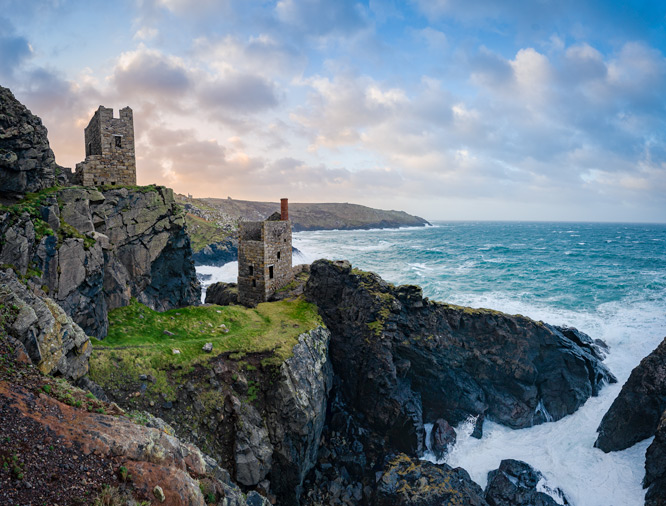
Yes — we are fully insured for all of our activities, with public liability cover up to £10 million. We also hold an AALA licence (Adventure Activities Licensing Authority) which is issued and monitored by the Health and Safety Executive.
You can verify our licence here. If you’d like copies of our insurance or risk assessments, just contact us.
We are based in Penzance, west Cornwall. Most of our sessions run at stunning coastal venues around Penzance, St Ives, Praa Sands, and Porthleven. We also offer coasteering on the Isles of Scilly.
• On the Isles of Scilly, sessions take place at Peninnis Head on St Mary’s.
• All meeting locations are confirmed 24–48 hours before your session based on the conditions.
Full directions are provided after booking.
Yes. All our sessions are led by highly experienced, fully trained guides.
- Coasteering: As there’s no official national governing body for coasteering qualifications, we place great emphasis on extensive in-house training, ongoing staff development, and many years of practical experience on the Cornish coastline. Our lead coasteering instructors also hold a range of nationally recognised qualifications in related fields, including rock climbing, mountain leadership, and first aid.
- Climbing: All climbing activities are run by qualified instructors holding recognised Mountain Training awards such as Rock Climbing Instructor or Mountaineering and Climbing Instructor, along with valid first aid certification.
As an AALA licensed provider, we also undergo regular inspections by the Health and Safety Executive to ensure our safety standards remain at the highest level.
In many cases, yes — but it depends on the activity and location:
- Coasteering: Some routes (such as Peninnis Head on the Isles of Scilly) allow good viewing opportunities. Others, like Land’s End, are hidden from view for safety reasons.
- Climbing: Our Beginner Rock Climbing courses often run at Trewavas Head, where friends and family can watch comfortably. More advanced climbing locations are generally not accessible to spectators.
Spectators are always responsible for their own safety.
We strongly recommend booking as early as possible, especially during the main season (spring to autumn). Some activities and dates fill up well in advance.
We welcome last-minute bookings, but availability cannot be guaranteed.
Private bookings, schools, and large groups should book several months ahead if possible.
Yes — within reason.
Isles of Scilly: Our sessions there typically run between Easter and late September.
Coasteering: We operate from spring through autumn, depending on weather and sea conditions.
Climbing: Rock climbing is possible year-round when conditions allow.
Our cancellation policy is simple:
- Full refunds are available for cancellations made more than 7 days before your session.
- Inside 7 days, we cannot guarantee a refund.
- If we need to cancel due to unsafe weather or sea conditions, you will be offered a reschedule or full credit.
Full terms are detailed on our Terms page.
We accept payment:
- Directly via our online booking system
- Bank transfer (BACS)
Payment in full is required at the time of booking, except for large groups where a deposit option may apply.
Yes — gift vouchers are available for any of our coasteering or climbing activities. You can purchase vouchers directly through our booking page.
Redemption is subject to availability, seasonal schedules, and minimum group sizes.
Yes — both coasteering and rock climbing are accessible to complete beginners. We provide:
- All specialist equipment
- Full safety briefing and instruction
- Suitable routes tailored to ability and conditions
If you’re unsure whether an activity is right for you, please feel free to contact us for advice.
Many people with minor medical conditions can take part safely, provided they disclose these before taking part.
- Conditions like asthma, mild diabetes or controlled blood pressure rarely prevent participation. For coasteering, we can carry any required medication in our waterproof safety bag.
- Please inform us in advance so we can advise you appropriately.
If in doubt, always consult your GP first.
Still curious? Read more about climbing and coasteering.
A Beginner's Guide to Coasteering
If you are visiting Cornwall, coasteering should be on your ‘to do’ list. This guide is for anyone coasteering for the…
Coasteering Around the World
Where can I go Coasteering? It is a question we often hear asked. It turns out the answer may…
5 Best Ways to Explore St. Ives
St. Ives is a jewel of the Cornish coast with arguably the prettiest…
Still wondering if coasteering or climbing is for you? Ask us anything — we’re here to help.


